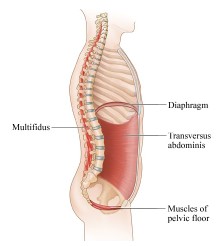What is the ‘Core’?
The idea that the core is just the spine, particularly the lumbar region, is palpably wrong: we are talking about the whole spine plus the pelvis/hips and shoulders. A well conditioned core is vital to help prevent injury and to enhance performance. Injury likelihood is increased if any part of the core is out of balance. A diverse range of factors such as muscle weakness or tightness, poor control or poor motor programming can increase the risk of injury.
Dysfunction of the core will lead to either weak or incorrect movement patterns, resulting in poor force transfer and often overloading the joints and tissues of the body.
How does the ‘Core’ system work in sport?
The body is comprised of 3 muscle systems: local stabilisers control movement at  individual joints, global stabilisers control body parts through motion and global mobilisers produce the actual movement we see in performance.
individual joints, global stabilisers control body parts through motion and global mobilisers produce the actual movement we see in performance.
Local stabilization is the ability of the muscles of the deep stabilising system to resist perturbations allowing the core to control the forces acting upon the joints, to produce an efficient base to perform movement. Spinal stability is linked to small deep muscles; Multifidus, Rotators Interspinalis and Intertransversalis, which provide intersegmental stiffness between the vertebrae. This stiffness is further enhanced by co-contraction of the deep muscles such as transversus abdominus, the pelvic floor and the diaphragm to increase intra-abdominal pressure while reducing compressive forces between the lumber vertebrae. This system should activate automatically, although pain or poor posture can interfere with this.
For forceful high velocity movements (often utilised in sporting situations) we require global stabilization on top of local stabilization. This is achieved through the superficial musculature system;
Rectus Abdominas, Obliques and the Erector Spinae group. This muscle system is linked to multi-segmental stiffness over a greater range, rather than just intersegmental stiffness seen in spinal stability; the system acts as a prime mover during dynamic activities, interacting with the muscles connecting the pelvis and shoulder girdle to transfer force from the spine to the limbs.

The core, therefore, is the kinetic link transferring forces between the upper and lower extremities in sporting actions. We are looking at combining a stable base with a torso that can produce and transfer force to produce a functional motor pattern, allowing a sequence of muscle contractions which promote movement efficiency.
Consequences of an inefficient ‘Core’ in sport
The correct sequencing of this system is vital for the efficient production and transfer of forces through the whole body. If we have a deficit within this system a compensatory (altered) movement pattern will result, taking us away from our ideal / most efficient motor program.
If spinal stiffness was not maintained while running for example: on ground contact of the stability of the trunk would be compromised, causing a longer ground contact of the feet and therefore a slower sprint. Traditionally attempts at correcting this are made by increasing leg strength and power. However, the problem may be far more proximal – the ability to stiffen the spine during ground contact would actually result in more efficient transfer of power from the legs to the ground and greater running velocity.
So, the take home message is if you do not have a stable base, do not expect your movement outcome to be optimal.
Role of Pilates
Pilates is an ideal way of training and challenging your base stability. Its aim is to enhance the recruitment patterns of the local stabilisers with basic movements and challenge these with more dynamic movements requiring greater involvement of the global stabilisers and global mobilisers.
Here at In Balance Physio and Pilates we offer both Pilates Mat and Equipment classes in an individual or group setting. If you are concerned about the condition or your core or interested in improving its efficiency and would like an assessment with one of our physiotherapists call the practice today to book an appointment.
Article by Leighton Bradgate April 2015
